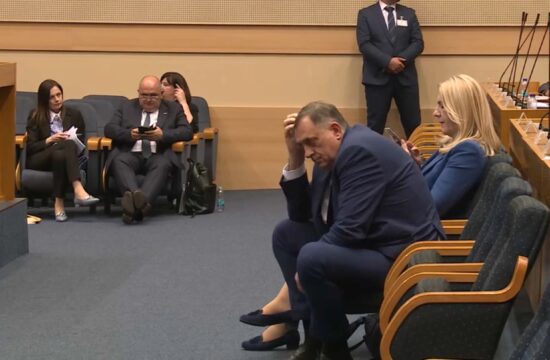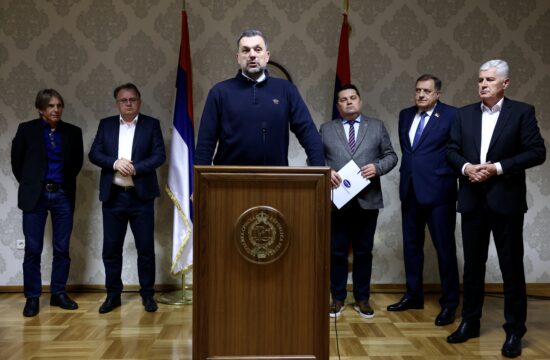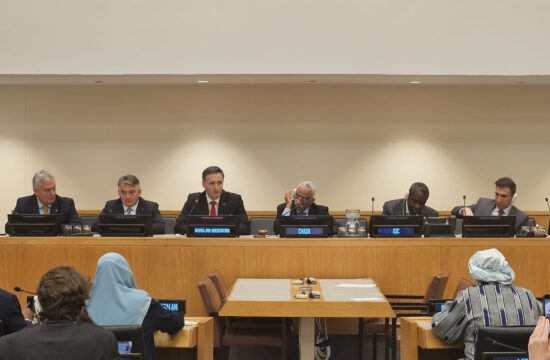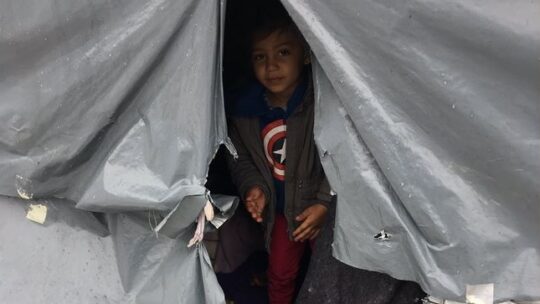
To mark the 25th anniversary of the Srebrenica genocide, N1 TV carried the testimonies of the genocide survivors, their memories of those killed in the massacre as well as success stories of the narrators, their efforts to build a better future through the remembrance culture, art, academic community, poetry and sports. All the stories were collected in the 'Revived' documentary.
Emir Sulejmanović, the basketball player of the Spanish ‘Bilboa’ team, was born on July 13, 1995, in the Luka village near Srebrenica. He lost his mother after he left Srebrenica. He was only five years old.
“I am very grateful to all the people who were there for my late mother to help her so that this birth goes through under the best possible conditions we could have at that time. We were in the woods, next to a big rock, as I was told. We left that place, we went to Žepa, and later we went to Kladanj, to our territory. We stayed there until we went to Finland, where our father was waiting for us. I am very thankful to my father, who was both mother and father to us at that time, to me and my brother,” said Sulejmanović.
As July 11 is approaching, Jasmin Jusufović recalls of the images of what he called an open hell of Potočari.
“The scene that will forever remain in my memory is of my late father being separated from me behind my back. As he remained on that ditch, in Potočari, holding my red jacket and saying goodbye to me. We found my father. We were told that he was found and identified in 2011. However, we buried him in 2012,” said Jusufović.
Damira Selimović, who was an 11-year-old girl in July 1995, remembers how everyone was forced to leave Srebrenica after its fall. They stopped for a moment to take some rest and say goodbye.
“Father and grandpa were supposed to go through the forest, and my brother and I went with mom to Potočari. A friend of my father had children's sneakers in his backpack and he wanted to leave them there saying he wouldn't be able to carry them. However, my father took those sneakers and put them in his backpack while telling us that we will need them when we arrive in Tuzla. My father never saw Tuzla, and neither did I see him again after that moment. He was killed in Kravica together with my grandfather, his father. He found his peace in Potočari ten years later. On July 11, 2005,” she said.
Alma Mustafić, a professor at the Utrecht University, was a little girl back in Srebrenica. She fled Srebrenica along with her mother, brother and sister, while her father stayed in the town.
“My father, Rizo Mustafić, worked for the United Nations, for Dutchbat 1,2 and 3, as an electrician. And he could count on special protection as a United Nations employee. But they didn’t do that and instead sent him outside of the compound, delivered him into the hands of the Serbs, and after that he was killed. Seven years ago we won a case against the Dutch state, which was found responsible for the death of my father,” said Mustafic.
Hasan Hasanović came to Bratunac 15 years ago, when former US President Bill Clinton opened the Potočari Memorial Centre. The police told him they couldn't go there by car due to the crowd so they approached the memorial on foot.
“And when we got off the bus, right there near the shopping mall, I saw several hundred local Serbs. The police were separating them from us, so we would have no physical contact. What I experienced that day was them spitting at us over the police cordon, saying derogatory things and calling us Turks. And I was going there to bury my father that day. There are no words I could use to describe how I felt. I knew that there were war criminals in that crowd. Imagine a war criminal who killed your father, who killed your brother, spitting at you and saying “I have won”. So, then I spent some time later thinking – do I hate? Because a lot builds up within a person. But considering that, as a person who could not hurt even the smallest animal, let alone a human being, you realise that you cannot even think about hating. That what is inside of you is the pain that has built up throughout all these years. And you realise that this is what they wanted to achieve in the end, to turn us into haters. We had every reason to be like that. However, we decided to take a totally different path. I think that the way I am today is my victory. That I travel around the world and I speak here now – that speaks about victory, my own and our victory. The victory of the survivors. That we have remained normal despite everything we endured. That we have formed our lives and got educated,” said Hasanovic, the curator and translator at the Memorial Centre.
Amila Akagic spent the 1992-95 period in Srebrenica as a juvenile girl. In order to escape the war reality, she was repeating some lessons multiple times, because, as she said, it was her light at the end of the tunnel.
“I have to single out a few professors who at that time influenced me and truly motivated me, whose moral norms are in a way imprinted deep into my character. Biology teacher Zejnil Velić and math teacher Zikret Džananović. Unfortunately, neither Zejnil nor Zikret, as well as many other professors from that period, are with us anymore. At that time, as a child, I was tasked with putting together a list of all the men of a certain age who are in Potočari, staying at that centre. And while putting together that list, I came across my teacher, Zikret Džananović, among others. And that was the last time I saw him. His hair too had in those three days, from July 11 to July 13, simply turned completely grey. I will stop here,” recalls Akagić.
Kemo and Kemail Hajdarević, two brothers who survived genocide. When they started the ‘death march’ Kemail was 15 and Kemo 20 years old.
“There’s one moment I will remember forever… a cry for help, a dreadful sound deeply engraved in my memory. The man was calling for help asking ‘don’t leave me, please’,” said Kemo Hajdarević, a PE teacher.
“A soldier shook my hand and that moment I felt I was alive again. It felt as if I was free again, that I reached the light. He told me: ‘You too?’ He didn’t try to comfort me, because we reached a free territory, but he said ‘Did you manage to survive, boy?’ I replied ‘ You tell me if this is free territory.’ And here is one anecdote. We got each a piece of bread and a 400 gram can but I asked for more, I felt I could eat more. But then, I could take only one bite. I couldn’t chew any of it,” said his brother, Kemail Hajdarević, a geography teacher.
Elvir Redžepović left Srebrenica in 1992 but he tried to return when he heard what was happening in his hometown.
“On the way to Srebrenica, somewhere near Nezuk, our group fell into a trap. I was stuck there for about six hours, lying in the woods, nobody could get close to me. But after a while, my comrades found a way to help me out, using their belts they created a noose and dragged me from that spot. My best man, Nedžad, was one of them as well as one of my best friends, Edin Čizmić, the Commander of the Helicopter Squadron in Sarajevo today. I am so grateful to both of my friends who did so much for me. To show it in a way, I named my son Edin,” recalls Redžepović.
The first house that was set on fire in Srebrenica was the house of Šefkija Hadžiarapović's mother.
“Luckily, she was not there on that day in April 1992, otherwise she would have died in that fire. My oldest brother who stayed in Srebrenica had died at the very beginning of the war. My brothers-in-law also stayed. My brother-in-law Hren Rudolf is the Catholic who was buried at the Potocari memorial. He was the husband of my late sister, who passed away two weeks ago. Many of my colleagues, workmates, friends and many more that would take time to mention now had died,” said Hadžiarapović, a retired math lecturer in Eindhoven.
Šukrija Meholjić recalls how he had to leave Srebrenica, stressing that Srebrenica has never left him and has been in his veins since his birth. He is telling the truth about Srebrenica through his cartoons, articles and speeches across the world.
“We’re witnessing the final phase of this genocide. This genocide has been going on for the past 35 years, it didn’t end in those few days of 1995. It’s very dangerous that the genocide is constantly denied accompanied by an anti-civilizational revision of historically proven facts and court verdicts. Twenty-five years after the war, we expected a Serbian Willy Brandt to show up. We mustn’t forget Srebrenica because it’s the most painful place on the face of Bosnia,” said Meholjić.
Ado Hasanović is a filmmaker who became a refugee at the age of 6. His father stayed in Srebrenica until 1995 and survived the genocide as he found a way out through the forests. Ado and his mother left the town and escaped to Tuzla in 1993.
“There are people in Srebrenica still living normal lives, so to say. For a foreigner to see that city it’s not normal to see a Bosniak and a Serb sitting somewhere and drinking coffee together. This happens in Srebrenica, in Bratunac, in Vlasenica and it’s good that it happens. One needs to know that a policy from that time was wrong and that the people engaged in that policy are still not all convicted,” said Hasanović.
Mirsad Bektić, a UFC fighter who lives in Canada, was born in 1992. He left the town as a baby alongside his mother and brothers.
“My father stayed there in Bosnia while my mother went to Italy with me and my brothers. I don’t remember much of Bosnia, I do a bit more of Germany. I was a child and didn’t have a home. We travelled everywhere,” he said.
Nerko Hadžiarapović teaches marketing at faculties in Utrecht and Amsterdam. He was born and grew up in Srebrenica.
“I have two sons, Mak Medo is 11 and Tamar is 8 years old, and a wonderful wife Maja, born in Zenica. Healthy children and a happy family are the greatest success one can achieve in life. That’s a privilege that many friends, acquaintances or family had no chance to see because they became the victims of genocide in Srebrenica. Samir, Alem, Vahidin, Mehudin and many others, the list is too long,” said Hadžiarapović
Alden Begić was in Sarajevo when the war broke out. He was a student. Fifty-six members of his close and extended family died in the Srebrenica genocide.
“Unfortunately, they did kill so many people but they didn’t kill us all. They didn’t kill us, because through our progress and education, through the education of our children we’ll continue. And what’s important is our connection with Srebrenica,” said Begić, internal medicine specialist at the Sarajevo University Clinical Centre.
Amela Mustafić was born in 1994 in Srebrenica. She writes the poetry and keeps the memory of the Srebrenica genocide. She wishes to write a better future of Bosnia and Herzegovina with her poems.
“That’s when my mother’s bosom was my only bed and my father’s hands my only roof. The stories of genocide made holes inside of me which I filled by writing poetry. In my poetry, all the mothers found the bones of their children. In my poetry, all the dead were saved. Saved in a windowless house. And through verses, they tell a story that war is the greatest nonsense and greatest evil. The survivors, they tell stories of success and lifting from the ashes and that peace is the biggest wealth we could have. Their peace knows not the meaning of the word hatred,” said Srebrenica-born poet.




